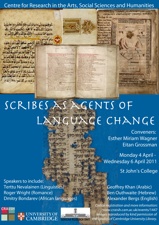Alexander Bergs: 'Writing, reading, language change - a sociohistorical perspective on scribes, readers, and networks in medieval Britain’
Duration: 24 mins 34 secs
Share this media item:
Embed this media item:
Embed this media item:
About this item

| Description: |
This paper investigates the relationship of authors and scribes in medieval Britain. It is shown that in many (late) medieval texts were in fact not autographed, but dictated in some way by their authors and actually produced by scribes. This naturally leads to the question what role scribes actually played. How influential were they with regard to the linguistic structure of the text they produced? The present paper argues that their influence may have been quite extensive when it comes to orthographical conventions, but that their influence on syntax and morphosyntax may have been much smaller than expected.
A second case study looks at a scribal innovation in written language features in the so-called Peterborough Chronicle from 1155, and discusses the possible motivation of the scribe and the patterns of innovation to found here. It also offers some speculation about why these new written language features did not catch on in the linguistic community. In its summary and conclusion this paper points out that current studies on linguistic change need to focus on both successful and unsuccessful innovations in linguistic change. The role of scribes as agents of linguistic change is an extremely complex one, and their actual part in the game can only be accurately identified, described, and analysed if we look at both actual changes and failed innovations. |
|---|
| Created: | 2012-03-01 16:36 |
|---|---|
| Collection: | Scribes as Agents of Language Change |
| Publisher: | University of Cambridge |
| Copyright: | E-M. Wagner |
| Language: | eng (English) |
| Distribution: |
World
|
| Keywords: | sociolinguistics; English; Paston letters; Peterborough Chronicle; |
| Explicit content: | No |
| Aspect Ratio: | 4:3 |
| Screencast: | No |
| Bumper: | UCS Default |
| Trailer: | UCS Default |
| Abstract: |
This paper investigates the relationship of authors and scribes in medieval Britain. It begins with a more general discussion of the various models of linguistic change that explicitly include written language as a source and medium for linguistic change. It is argued that both Samuels (1972) and Angus McIntosh (1956) provide valuable input here since Samuels’ model does not prioritize in any way written or spoken language as possible sources of linguistic change (in other words: change can actually begin in the written medium!), and McIntosh’s model explicitly puts written language and its systematicity at its center. Both of these models are important for studies on the influence of scribes, as scribes first and foremost are actors in the written, not the spoken medium. As a next step, this paper discusses the production of (late) medieval texts. It is shown that many texts were in fact not autographed, but dictated in some way by their authors and actually produced by scribes. There are, for example, virtually no writings by female author/scribes left since there was an extremely high degree of illiteracy among female speakers before about 1600. Nevertheless, we do have texts by female authors. This naturally leads to the question what role scribes actually played. How influential were they with regard to the linguistic structure of the text they produced? The present paper argues that their influence may have been quite extensive when it comes to orthographical conventions, but that their influence on syntax and morphosyntax may have been much smaller than expected. In order to discuss this claim, this paper presents one case study on the late Middle English Paston letters, i.e. 421 family documents (about 450.000 words) produced by members of the Paston family between 1421 and 1503. Some family members wrote their own texts and worked as scribes for others. Similarly, some identifiable scribes worked for more than one family member. A detailed study of two morphosyntactic variables (the new th-pronouns and relative clauses) shows that in both cases there is no distinct scribal style to be identified. On the contrary. Scribes show very different linguistic behavior when writing for different authors, including themselves. This leads us to suspect that their influence at least in the domain of morphosyntax may have been fairly limited. A second case study looks at a scribal innovation in written language features in McIntosh’s sense. The last continuation of the Anglo-Saxon Chronicle, the so-called Peterborough Chronicle from 1155 is characterized by a very unusual use of the new digraph <th> for the former runic graphemes <Þ> and <đ>. These graphemes were extremely rare before the Peterborough Chronicle and for about 250 years afterwards. This paper discusses the possible motivation of the scribe and the patterns of innovation to found here. It also offers some speculation about why these new written language features did not catch on in the linguistic community. In its summary and conclusion this paper points out that current studies on linguistic change need to focus on both successful and unsuccessful innovations in linguistic change. The role of scribes as agents of linguistic change is an extremely complex one, and their actual part in the game can only be accurately identified, described, and analysed if we look at both actual changes and failed innovations. |
|---|---|
Available Formats
| Format | Quality | Bitrate | Size | |||
|---|---|---|---|---|---|---|
| MPEG-4 Video | 480x360 | 1.84 Mbits/sec | 339.90 MB | View | Download | |
| iPod Video | 480x360 | 505.37 kbits/sec | 90.93 MB | View | Download | |
| MP3 | 44100 Hz | 125.07 kbits/sec | 22.26 MB | Listen | Download | |
| Auto * | (Allows browser to choose a format it supports) | |||||

